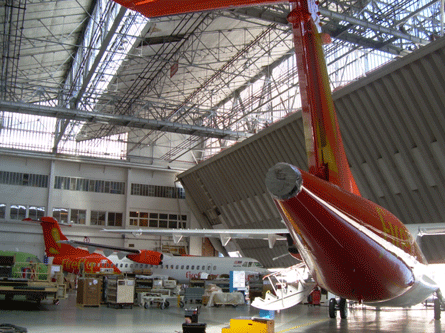ATR is accelerating studies into a new turboprop family for service entry around eight to 10 years from now that will include up to three variants with increased composites use and a higher-capacity baseline compared with its existing products.
ATR chief Stephane Mayer says the studies are focusing on a family optimised to around 70-98 seats. Through this project, ATR is aiming to deliver reduced emissions, cut operating costs by 15-20% and meet demand for a higher capacity turboprop.
"We have defined some objectives, based on the market. One is a new engine, another is composites, but we are still just beginning to explore the paths," Mayer says.
 |
|---|
©Victoria Moores/FlightPropellors on the Toulouse production line, waiting to be fitted to an aircraft |
Service entry is targeted for "the second half of the next decade" he says and ATR is "accelerating the pre-study phase". He adds that the project will need a sound business case and, although there is a market, the current low dollar value means "we have to be careful".
Mayer is confident of the market for at least two family members at each end of the 70- to 98-seat spectrum. A 50-seater is also under evaluation, but Mayer is unsure whether sufficient demand exists to justify a third variant that would have to be significantly cheaper than the 70-seat aircraft.
 |
|---|
© Victoria Moores/FlightATR aircraft in production in Toulouse |
He says: "If there is market, we would prefer to propose three. The question is whether we want to stay in the [50-seat] market and if there is a market or a business case."
The precise optimisation point for the new family has not been fixed, but the ATR chief also wants to avoid a 50-seat member being sub-optimal and unsuccessful.
Mayer says the new family will boast a wide range of improvements: "It might look like an ATR, but it will be almost a new generation. If you change the fuselage, the wing and the engines, it becomes a new aircraft."
He adds that ATR has essentially ruled out a stretch of its existing products: "Our customers expect lower costs and for that we will need a technological breakthrough, which means introducing better aerodynamics using the latest computer-generated models and a lighter aircraft with even more composites use."
ATR plans to tap the composites skills of its shareholders, Alenia Aeronautica and EADS, to update its fuselage materials and cut aircraft weight.
Alenia Composite chief operating officer Maurizio Rosini says one-piece barrel composite technology could feasibly be applied to the ATR, although it would require further analysis.
The new family will also have lighter seats and improved cabin comfort, although key cost savings are likely to stem from its powerplant technology.
ATR is discussing its engine options with Pratt & Whitney and Rolls-Royce, but Mayer says: "We have not stopped talking with those two and we have added others."
Source: Flight International
















